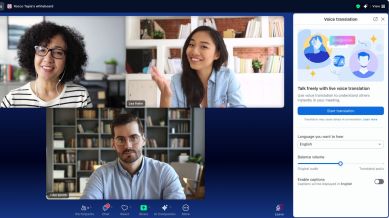Zoom introduces AI avatars, smarter AI assistant with cross-platform agentic skills
At Zoomtopia 2025, Zoom unveiled AI Companion 3.0 that is capable of taking notes even in Google Meet, Microsoft Teams, and in-person meetings.

Zoom has introduced a new feature that might soon make attending Zoom meetings yourself a thing of the past. The video communication and collaboration platform will let users create photo-realistic, AI-generated avatars of themselves to appear in online meetings on their behalf.
The AI avatar will be able to track and mimic users’ live video feed. It is one of several AI-powered updates unveiled at Zoomtopia 2025, the company’s annual flagship event showcasing its latest innovations. “For the moments that require a polished presence without being “camera-ready,” participants will be able to use a lifelike AI-generated avatar based on their likeness,” the California-based company said on Wednesday, September 17.
The AI avatar feature is expected to be rolled out in December this year. It comes days after Zoom CEO Eric Yuan predicted that AI chatbots and agents will shorten the average working week to just three or four days. “I feel like if AI can make all of our lives better, why do we need to work for five days a week? Every company will support three days, four days a week. I think this ultimately frees up everyone’s time,” Yuan was quoted as saying in a recent interview.
Zoom on Wednesday also introduced AI Companion 3.0, its upgraded AI assistant that now has the ability to generate notes in meetings held in-person as well as on other platforms such as Google Meet, Microsoft Teams, etc. However, this feature is only available for paid users with Zoom Workplace accounts.
When asked whether the company is worried about third-party platforms restricting access to Zoom AI Companion 3.0, Smita Hashim, chief product officer at Zoom, told The Indian Express, “We are certainly seeing a trend where we are seeing some incumbents starting to restrict access. But we are not seeing a broad spread around that. I think a lot of the players recognise that they want customers to have choices and we are seeing them embrace that.”
“It is something which we continue to watch and work with our partners about. Our customers definitely do not want the data to be restricted,” Hashim added.
Zoom first gained widespread recognition during the COVID-19 pandemic, when remote work and virtual meetings became the norm. Since then, the company has looked to become more than a video conferencing platform by launching AI-powered productivity tools and customer support products for enterprises. It has sought to define its competitive edge in the crowded AI industry by taking a federated approach where multiple AI models, including Zoom’s own models and those from OpenAI, Anthropic, and Meta, are dynamically selected to provide cost-effective solutions.
“Our customers’ most important conversations happen on Zoom, and now those conversations can result in critical insights to fuel real progress. With AI Companion 3.0, our agentic AI can understand users’ specific context, priorities, and goals to help them cut through the noise, focus on what matters most, and drive meaningful business outcomes,” Yuan said.
AI Companion 3.0: Features and updates
Besides note-taking capabilities, AI Companion 3.0’s agentic feature will let users retrieve information across Zoom Workplace, as well as Google and Microsoft platforms (if enabled), to create documents and other assets. It also comes with deep research skills and improved writing assistance.
AI Companion 3.0 uses agentic AI to schedule meetings for users. It has a feature called ‘free up my time’ which suggests meetings that users can skip based on “the tasks they need to get done in a day, and their participation and role within the meeting.” The AI assistant also provides in-meeting recommendations and pointers to prepare for upcoming meetings so that users know the agenda, previous action items, and key insights beforehand. Zoomie Group Assistant enables easier group collaboration across meetings and chats by answering questions about the group’s work such as ‘What are the team’s action items?’
The AI assistant has also been designed to flag potential conflicts such as when participants have booked different rooms for the same meeting. These features are expected to become available from November this year. Zoom AI Companion 3.0 can be accessed at no additional cost by paid users with Zoom Workplace subscriptions starting from Rs 1,376 per month. “The inclusion of AI features at no additional cost is especially helpful for small business owners and solopreneurs on our platform for whom every rupee counts,” the company said.
Other announcements
Zoom Workplace users will have access to a range of new features such as real-time voice translation for Zoom Meetings, the ability to generate clips from presentations, 60fps high frame rate video quality, etc. They can also access apps within Team Chat, Zoom’s instant messaging service, and generate collaborative documents directly from Zoom meeting discussions with Zoom Whiteboard.
The company also offers a Rs 1,999 subscription package called Zoom Business. These subscribers will be able to access features such as Agentic AI Expert Assist to automate support agent tasks, AI-generated customer experience (CX) insights, Automated Quality Management (AQM) to oversee virtual customer-agent interactions, and more. While most of these features will be rolled out this year, AQM access will become available from January 2026.
Additionally, Zoom has introduced a new capability in Zoom Virtual Agent (ZVA) where users can upload a short sample of their voice to create a customised conversational experience. From January next year, Zoom will let healthcare industry stakeholders “build virtual agents tailored to clinical and administrative workflows, such as patient intake, scheduling, insurance verification, and post-visit follow-ups.”
Its Zoom Video Management platform has been upgraded to let educational institutions manage lecture recordings, training, and projects across departments on a single platform.